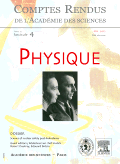
COMPTES RENDUS PHYSIQUE
Scope & Guideline
Advancing the Frontiers of Physics and Astronomy
Introduction
Aims and Scopes
- Quantum Physics and Measurement Theory:
The journal frequently explores topics related to quantum mechanics, including quantum measurement, many-body systems, and the implications of quantum theory on physical phenomena. This area reflects a commitment to understanding the foundations and applications of quantum physics. - Astrophysics and Atmospheric Physics:
A consistent focus of the journal is on astrophysical phenomena, particularly the effects of atmospheric conditions on astronomical observations. Topics include atmospheric turbulence, refraction, and the study of celestial bodies, showcasing the intersection of physics and astronomy. - Condensed Matter Physics:
The journal publishes research on materials science, particularly studies involving two-dimensional materials, superconductivity, and transport phenomena. This includes investigations into the electronic properties and dynamics of novel materials, emphasizing experimental and theoretical approaches. - Historical and Pedagogical Insights in Physics:
There is a notable inclusion of historical commentaries and educational perspectives in physics, reflecting on the evolution of concepts and theories. This aspect aims to provide context and foster a deeper understanding of the scientific process. - Applied Physics and Engineering:
Research related to practical applications of physics, including advancements in telecommunications (such as 5G technology) and materials engineering, highlights the journal's commitment to bridging fundamental physics with real-world applications.
Trending and Emerging
- Quantum Technologies and Measurement:
The exploration of quantum measurement techniques and theories related to many-body systems is increasingly prominent. This trend reflects a growing interest in the practical applications of quantum mechanics in technology and measurement science. - Advanced Materials and Nanotechnology:
There is a significant increase in research related to two-dimensional materials, nanostructures, and their unique properties. This trend underscores the importance of materials science within condensed matter physics and its applications in electronics and photonics. - Astrophysics and Space Sciences:
The journal has seen a rise in studies focused on astronomical phenomena and atmospheric effects on observations. This trend indicates a robust interest in understanding celestial mechanics and the impact of Earth's atmosphere on astrophysical research. - Interdisciplinary Research Linking Physics and Engineering:
Emerging themes include the application of physics in engineering challenges, particularly in telecommunications and materials engineering. This trend highlights the journal's role in facilitating the dialogue between fundamental physics and practical engineering solutions.
Declining or Waning
- Classical Mechanics and Basic Physics:
There seems to be a diminishing emphasis on traditional topics in classical mechanics, as contemporary research increasingly gravitates towards quantum phenomena and advanced materials. This shift may reflect a broader trend in physics research prioritizing innovative and cutting-edge topics over foundational mechanics. - Historical Perspectives on Classical Theories:
Although historical commentaries have been a part of the journal's offerings, the frequency of papers focusing on classical theories and their historical significance has decreased. This could indicate a reduced interest in revisiting classical concepts in favor of contemporary developments and applications. - Thermodynamics and Statistical Mechanics:
Research articles specifically centered on thermodynamics and statistical mechanics appear to be less frequent. This may reflect a broader trend where newer areas like quantum thermodynamics and nonequilibrium systems are gaining more traction in the physics community.
Similar Journals
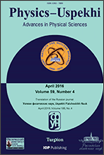
PHYSICS-USPEKHI
Elevating Peer-Reviewed Scholarship Since 1993PHYSICS-USPEKHI, published by Uspekhi Fizicheskikh Nauk, is a prominent peer-reviewed journal in the field of physics and astronomy, reaching researchers and professionals since its inception in 1993. With an ISSN of 1063-7869 and an E-ISSN of 1468-4780, this esteemed journal has been classified as Q2 in the Physics and Astronomy category based on the 2023 quartiles, ranking 74 out of 243 journals in its Scopus classification, placing it in the 69th percentile. Although currently not an open access journal, it provides invaluable insights and advancements in the field, fostering an environment for scholarly exchange and collaborative research. Based in Moscow, Russia, PHYSICS-USPEKHI continues to shape the landscape of theoretical and experimental physics, inviting submissions that contribute to its rich legacy of high-impact scientific discourse.

Romanian Journal of Physics
Fostering global collaboration in scientific inquiry.Welcome to the Romanian Journal of Physics, a distinguished platform dedicated to advancing the field of physics and astronomy since its inception. Published by EDITURA ACAD ROMANE, this journal plays a pivotal role in disseminating high-quality research from Romania and around the globe, with an impressive impact factor that reflects its rigorous academic standards. With a focus on a broad range of topics in general physics and astronomy, it proudly maintains a Q2 ranking in its category for 2023, positioning itself among the top journals in the field. The journal, which has been converging valuable research contributions from 2008 until 2024, is accessible to a wide audience of researchers, professionals, and students interested in the latest developments and discoveries in physics. While it operates under a traditional publication model without Open Access, its commitment to quality research ensures that the contributions featured in its pages resonate well within the scientific community. We invite you to explore the rich findings published in the Romanian Journal of Physics and to engage with the vital discussions shaping the future of physics.
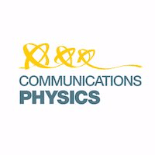
Communications Physics
Bridging gaps with groundbreaking findings.Communications Physics is a premier open access journal published by Nature Portfolio, dedicated to disseminating high-quality research in the field of Physics and Astronomy. Since its inception in 2018, the journal has rapidly established itself as a vital platform for innovative scientific communication, boasting an impressive Impact Factor and achieving Q1 status in the 2023 category of Physics and Astronomy (miscellaneous). With a Scopus rank of #31 out of 243, placing it within the 87th percentile, Communications Physics attracts a global audience of researchers, professionals, and students eager to engage with cutting-edge findings. The journal supports open access, ensuring that research is freely available to the public, which enhances its visibility and encourages broader discussions within the scientific community. Located in Berlin, Germany, Communications Physics aims to bridge the gap between various disciplines within physics, fostering interdisciplinary collaboration and inspiring future research endeavors.
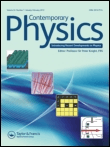
CONTEMPORARY PHYSICS
Advancing Knowledge Through Innovative ResearchCONTEMPORARY PHYSICS, published by Taylor & Francis Ltd, stands as a notable journal in the field of physics and astronomy, offering a comprehensive platform for the dissemination of cutting-edge research and developments since its inception in 1959. With an Impact Factor that reflects its solid position within the academic community, as evidenced by its Q2 ranking in the 2023 category of Physics and Astronomy (miscellaneous) and a Scopus Rank of 111 out of 243, this journal plays an essential role in bridging theoretical advances and practical applications. Researchers and professionals are encouraged to explore its diverse scope, which aims to foster innovative ideas and foster interdisciplinary collaboration. Although not currently an open access journal, CONTEMPORARY PHYSICS is committed to maintaining the highest standards of editorial excellence and provides valuable insights across converged eras of research from 1959 to 2024, making it indispensable for those dedicated to advancing their knowledge and contributions in the realm of physics.

ACTA PHYSICA POLONICA A
Championing Research Excellence since 1996ACTA PHYSICA POLONICA A is a distinguished peer-reviewed journal published by the Polish Academy of Sciences Institute of Physics, offering a platform for disseminating cutting-edge research in the field of physics and astronomy. With an ISSN of 0587-4246 and an E-ISSN of 1898-794X, this journal has been a staple for scholars since its inception, converging its publication years from 1996 to 2024. Despite its current Q4 classification in the Physics and Astronomy (miscellaneous) category, ACTA PHYSICA POLONICA A provides valuable insights and breakthroughs addressing various aspects of general physics. Researchers, professionals, and students will find a wealth of knowledge within its pages, even as it operates in an evolving academic landscape. While subscription options exist, the journal aims to foster collaboration and knowledge exchange in the physics community, making it a vital resource for those seeking to stay at the forefront of research advancements.

ACTA PHYSICA SINICA
Exploring New Dimensions in Physics ResearchACTA PHYSICA SINICA is a prominent journal published by the Chinese Physical Society, dedicated to the dissemination of groundbreaking research in the field of physics and astronomy. Established in 1993, this journal has consistently contributed to the scientific community by publishing high-quality articles that cover a wide range of topics within general physics and related disciplines. Although currently classified in Q4 of the physics and astronomy category by Scopus, ACTA PHYSICA SINICA plays an important role in fostering collaboration and communication among researchers in China and around the world. With a substantial readership, this journal is poised to remain a valuable resource for professionals, researchers, and students alike. By providing in-depth analysis and insights, it aims to advance the understanding and application of physical principles in various technological and scientific advancements. The journal is accessible via subscription, ensuring that contributors and readers can engage with the evolving landscape of physics research. For more information, visit the publisher's website.
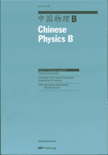
Chinese Physics B
Illuminating the path of scientific discovery in physics.Chinese Physics B, published by IOP Publishing Ltd, is a distinguished journal in the field of Physics and Astronomy, offering a platform for researchers to disseminate cutting-edge studies and advancements. With an ISSN of 1674-1056 and an E-ISSN of 2058-3834, this journal emphasizes open access, ensuring that groundbreaking research is readily available to a global audience. Reflecting its commitment to quality, Chinese Physics B is categorized in the Q3 quartile (2023) in its subject area and ranks 118 out of 243 among its peers in general physics and astronomy according to Scopus, placing it in the 51st percentile. Publishing since 2008, the journal not only maintains a rigorous peer-review process but also aims to foster collaboration among academics in various physics disciplines. With its base in the United Kingdom, Chinese Physics B remains a crucial resource for those seeking to stay abreast of developments in the diverse world of physics.
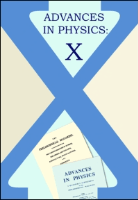
Advances in Physics-X
Shaping Tomorrow’s Physics with Today’s ResearchAdvances in Physics-X is a premier open-access journal published by Taylor & Francis Ltd, dedicated to advancing the frontiers of knowledge in the field of Physics and Astronomy. Since its inception in 2016, the journal has established itself as a vital platform for researchers and professionals, showcasing innovative research and cutting-edge theories that influence a broad array of sub-disciplines within physics. With an impressive impact factor and ranked in the 94th percentile among its peers, it resides in the Q1 category for Physics and Astronomy (miscellaneous), indicating its significant contributions to the academic community. Located in the United Kingdom, the journal encourages open access to foster wider dissemination and visibility of scholarly works, aligning with contemporary academic trends that prioritize global knowledge sharing. The ongoing commitment to publishing high-quality research ensures that Advances in Physics-X remains an essential resource for students, industry experts, and academics alike, helping to shape the future of physics research through collaboration and innovation.

BRAZILIAN JOURNAL OF PHYSICS
Pioneering Discoveries in Brazilian PhysicsBRAZILIAN JOURNAL OF PHYSICS, published by SPRINGER, is a prominent platform dedicated to the dissemination of research within the realm of physics and astronomy. With an ISSN of 0103-9733 and E-ISSN of 1678-4448, this esteemed journal has been contributing to the field since its inception in 1996, and it continues to be pivotal in showcasing innovative studies and breakthroughs. The journal is categorized in the Q4 quartile for the year 2023, reflecting a dedicated focus on advancing knowledge across a variety of disciplines, particularly in general physics and astronomy, where it ranks 126th out of 243 in Scopus rankings. Although it currently does not operate under an open-access model, it remains an invaluable resource for researchers, professionals, and students eager to enhance their understanding of complex physical principles and developments. The journal is committed to promoting high-quality research, bridging gaps in knowledge, and fostering collaboration within the global physics community.

Bulletin of the Lebedev Physics Institute
Exploring complex concepts for a global audience.Bulletin of the Lebedev Physics Institute is a peer-reviewed journal dedicated to advancing the field of physics and astronomy, published by PLEIADES PUBLISHING INC. With a print ISSN of 1068-3356 and an e-ISSN of 1934-838X, this journal has been an essential platform for disseminating significant research findings since its inception in 2009. It continues to provide insight into various areas of general physics and astronomy, and consistently aims to foster innovative discussions among researchers and scholars. Although currently positioned in the Q4 category within the 2023 Scopus rankings, it serves a vital role in linking emerging trends with established research, catering to a global audience seeking to explore complex concepts within the field. By contributing to the body of knowledge, the Bulletin supports academic growth and collaboration across diverse sectors. Despite its challenges in ranking, the journal’s unique perspectives and ongoing publications underscore its commitment to pushing the boundaries of scientific inquiry in the United States and beyond.